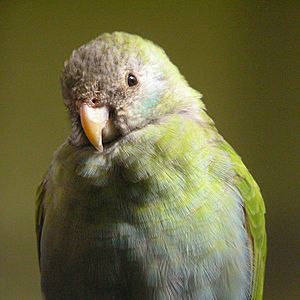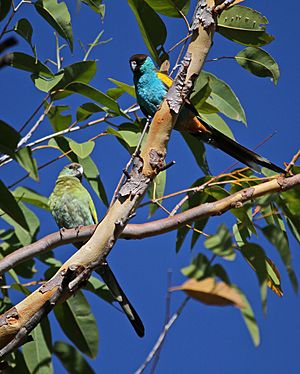Hooded parrot facts for kids
Quick facts for kids Hooded parrot |
|
|---|---|
 |
|
| A pair in Australia. The male is in the foreground. | |
| Conservation status | |
| Scientific classification | |
| Genus: |
Psephotellus
|
| Species: |
dissimilis
|
| Synonyms | |
|
Psephotus dissimilis |
|
The hooded parrot (Psephotellus dissimilis) is a colorful bird that lives in the Northern Territory of Australia. You can find it in grassy areas called savannahs and open woodlands. This parrot is special because it builds its nests inside termite mounds. Sadly, there are fewer hooded parrots now than there used to be in many places.
Contents
About the Hooded Parrot
Naming and History
The hooded parrot is one of three types of birds sometimes called "antbed parrots." It is very similar to the golden-shouldered parrot. Scientists think these two parrot types separated a very long time ago, millions of years ago.
A scientist from Norway named Robert Collett first described the hooded parrot in 1898. Its scientific name, dissimilis, comes from a Latin word meaning "different." This name might refer to how the male and female parrots look different, or how it looks different from its closest relatives. Sometimes, people also call it the "black-hooded parrot."
What Hooded Parrots Look Like
The hooded parrot is a medium-sized bird. It can grow up to 26 centimeters (about 10 inches) long and weighs about 50 to 60 grams (about 2 ounces).
Male Hooded Parrots
Male hooded parrots have a black head and a bluish-grey beak. Their eyes are dark brown. They have a bright yellow patch on their wings. Their upper body is brown, and their lower body is a pretty turquoise blue. Their tail is olive green with pale blue tips. Their legs are pink-grey.
Female and Young Parrots
Female hooded parrots are a duller green color. They have a grey-brown head and pink feathers under their tail. Young parrots look a lot like the females.
Comparing with Similar Parrots
It can be tricky to tell the male hooded parrot apart from the male golden-shouldered parrot. The hooded parrot male does not have a pale band on its forehead. It also has a bigger yellow patch on its wings and no red on its belly. Female hooded parrots are also very similar to female golden-shouldered parrots. The main differences are that the female hooded parrot doesn't have a pale band on its forehead or red on its belly.
Where Hooded Parrots Live
Habitat and Location
The hooded parrot lives only in Australia. It is found in the dry, semi-desert areas of the northeast Northern Territory. A natural barrier, called the Carpentarian faunal barrier, separates it from the golden-shouldered parrot.
Conservation Status
Even though this parrot has disappeared from some places where it used to live, it is still common in areas that are protected. Because of this, the IUCN Red List of Threatened Species lists the hooded parrot as "Least Concern." This means it is not currently in danger of disappearing.
Hooded Parrot Life and Habits
What They Eat
Hooded parrots mostly eat seeds, berries, and different kinds of vegetables.
Nesting and Reproduction
Hooded parrots are special because they dig holes to nest inside termite mounds. They usually pick tall, cone-shaped termite mounds. If the mound is flat, they will dig at the edge instead of the flat side. It takes them about three weeks to dig their nest tunnel. The tunnel goes mostly straight into the mound and is about 50 to 80 centimeters (about 20 to 31 inches) long.
Hooded parrots usually breed once or twice a year, between April and August. The female lays four or five white, slightly shiny eggs. Each egg is about 21 millimeters long and 19 millimeters wide.
A Special Relationship with Moths
The hooded parrot has a very interesting relationship with a type of moth called Trisyntopa neossophila. The female moth lays her eggs inside the parrot's nest hole. She times it so her eggs hatch at the same time as the baby hooded parrots. The moth larvae (baby moths) live in small tunnels at the bottom of the nest. They come out to eat the dark parts of the parrot's droppings, leaving the white parts behind. They also build a silky layer at the bottom of the nest to protect themselves from the parrot chicks. Once the young parrots leave the nest, the moth larvae turn into pupae inside the nest walls.
Dangers to Hooded Parrots
Some animals, like the goanna species Varanus tristis, have been seen raiding hooded parrot nests to eat their eggs.
The termite mounds where these parrots nest can be damaged by cattle in areas where cows are raised. This can destroy the parrots' nesting sites. Also, a group of 28 young parrots once died after drinking water that was polluted with tar from a spill next to a road.
Hooded Parrots as Pets
Hooded parrots can be kept as pets and often breed well in captivity. However, they can be aggressive, so it's usually not a good idea to keep them with other types of parrots in the same cage. They became much more popular as pets in Australia in the 1980s. There is even a special yellow version of the hooded parrot that has been bred by people.
Images for kids
See also
 In Spanish: Perico capirotado para niños
In Spanish: Perico capirotado para niños





